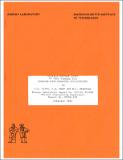Delayed neutron assay to test sorbers for uranium-from-seawater applications
Author(s)
Nitta, Cynthia K.; Best, F. R.; Driscoll, Michael J.
DownloadEL_TR_1982_008.pdf (7.830Mb)
Metadata
Show full item recordAbstract
Delayed Fission Neutron (DFN) assay has been applied to the measurement of uranium content in sorbers exposed to natural seawater for the purpose of evaluating advanced ion exchange resins. DFN assay was found to be particularly suitable for such testing because it is selective, nondestructive, yields quantitative results in the submicrogram range, and requires relatively simple sample preparation. Surplus components for a DFN system were obtained from the Lawrence Livermore National Laboratory, modified, re-assembled, and calibrated for use with M.I.T. irradiation facilities, following which procedures were developed, evaluated and applied to the experiments at hand. Four experimental ion exchange resins developed by the Rohm and Haas (R&H) Company specifically for uraniumfrom- seawater applications were evaluated, together with hydrous titanium oxide (HTO), the leading inorganic sorber for this purpose. Two types of tests using natural seawater were employed: batch loading experiments (paralleling similar tests done by R&H), and fixed-bed column loading experiments using a test facility at the Woods Hole Oceanographic Institute (WHOI). While some qualitatively consistent trends were evident among the various experiments, important quantitative inconsistencies were noted. The WHOI tests most closely approximated true in-service conditions; hence, more importance is assigned to these results. The MIT/WHOI tests confirmed 1.5 mm HTO particle bed uptake of approximately 300 ppm U for a 30 day exposure, in good agreement with the results reported by other laboratories, worldwide. An anion exchange resin employing an amidoxime functional group also achieved this level of performance, and, in addition, exhibited considerably superior mechanical properties. Moreover, the resin performance is expected to improve when its properties are optimized for the present application.
Date issued
1982Publisher
Cambridge, Mass. : Massachusetts Institute of Technology, Energy Laboratory, 1982
Series/Report no.
Energy Laboratory report (Massachusetts Institute of Technology. Energy Laboratory) no. MIT-EL 82-008.MITNE ; no. 249.